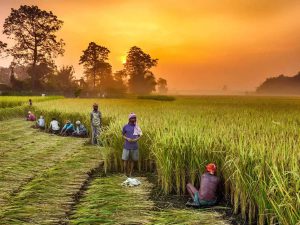‘Scale of finance’, a measure of loans permissible per acre per crop, varies across districts, causing confusion. It must be harmonised
The Modi government had rolled out an innovative loan scheme for farmers engaged in animal husbandry and fisheries in February 2019. The scheme was to provide short-term loans for activities such as dairy farming, poultry, sheep and goat rearing and fisheries which are income-supplementing activities for most farmers.
Till then, these were not eligible for interest subsidies as available for crop cultivation. It was a brilliant move. Right now, the scheme seems to be stuck on a very minor but significant factor in the farm credit programme in the country.
The United Progressive Alliance started the practice of including the targets for bank loans to the farm sector as part of the Budget. The media has also been reporting it as if it were an integral part of the financial statements of the Budget.
Few know that the credit disbursal for agriculture has nothing to do with the Budget per se. These figures represent the disbursals by the banks as part of the Kisan Credit Card (KCC) scheme. If these are part of the Budget, one could as well do the same for credit for housing, MSMEs, and so on.
Kisan Credit Card
KCC loans are given to farmers for crop cultivation as a running account facility. The Centre extends interest subsidy to the farmers up to 5 per cent if there is prompt repayment and the effective rate is only 4 per cent per annum.
KCC loans constitute around 60 per cent of loans for agriculture and allied activities by banks and are an important vehicle of credit delivery. Simplification and rationalisation of the KCC loan process is, therefore, a vital part of agricultural reforms. For farmers all over the country, KCC provides much succour.
KCC loans hinge on what is known as the Scale of Finance (SoF), which is a measure of the loans that can be given per acre per crop. For instance, if the crop is paddy the farmer gets, say, about ₹23,000 per acre whereas if it is sugarcane, the amount is ₹44,000.
While almost all other parameters of lending have undergone a change this one animal, the SoF, has not changed its spots. For bankers, the SoF is sacrosanct as the government and the RBI rely upon it while passing on interest subsidy for crop loans.
For farmers, this is important as no power on earth (or even above) can alter the loan amount based on the SoF. In fact, even illiterate farmers know the term Scale of Finance — eScale of Finance in the heartland. It is one English term, localised into Hindi, Bengali, Gujarati, Maithili and almost all our dialects.
As per RBI directives, for each of the crops that banks finance, the SoF is to be determined by the District Level Technical Committee (DLTC) which consists of banks, NABARD representatives and a few officers of the State government. The DLTC will “deliberate” and arrive at the maximum amount that can be given for different crops. It can differ from district to district within the same State.
For instance, in Madhya Pradesh, which has 52 districts now, there are at least 30 different scales of finance for the same crop. For soyabean, it ranges from ₹18,500 per acre to ₹54,000 per acre. For banks which operate all over the country, the district-wise SoF is a maze within a haze wrapped in overall confusion. One very sensible suggestion which has come up is to have uniform SoF for all the 23 crops for which there is anyway a uniform MSP (Minimum Support Price). The MSP is calculated based on demand and supply; cost of production; price trends in the market, both domestic and international; inter-crop price parity; terms of trade between agriculture and non-agriculture; a minimum of 50 per cent as the margin over cost of production; and likely implications of MSP on consumers of that product.
MSP is based on a comprehensive matrix of parameters, vetted by experts and undergoes an annual review.
A national SoF
If the output price can be uniform and can be common across the country, one fails to understand why there should be different SoF for different districts. We could at least have a national band for the SoF. Theoretically, going by current norms, there could be more than 700 SoFs for a nation-wide crop like paddy.
The logic for a national SoF for the 23 crops for which there is a uniform MSP is being announced is self-evident. The same holds good for the short term finance for animal husbandry and fisheries.
If someone were to say that “oh no, but there are regional variations and local factors” — the template response to such questions — the counter question would be “then don’t we need to have District-level MSPs too?”
Out of sync
It is quite arguable that the norm of an SoF itself is out of sync with our liberalised times. If you are financing housing, the per square feet cost based on which you will give a housing loan is not based on any SoF. If a banker were to finance a steel unit, there is no uniform, rigid SoF per tonne that he follows.
Even for consumption loans like those to salary holders, individual banks are free to fix the quantum of finance that they want to give. But when it comes to crop loans for farmers, well, it has to be rationed!
One nation, one election is a poll reform idea mooted by Prime Minister Modi. While that idea may be political, there is surely a case for one nation, one MSP, one SoF.
Coming to think of it, this is just a minor step by the RBI/Government/NABARD in agricultural reform but it will be a giant leap for simplifying and rationalising credit delivery for our hard-working farmer friends. And it will give the necessary push to the pioneering scheme of KCCs for allied agri activities with interest subsidies and go a long way in increasing farmers’ incomes.




